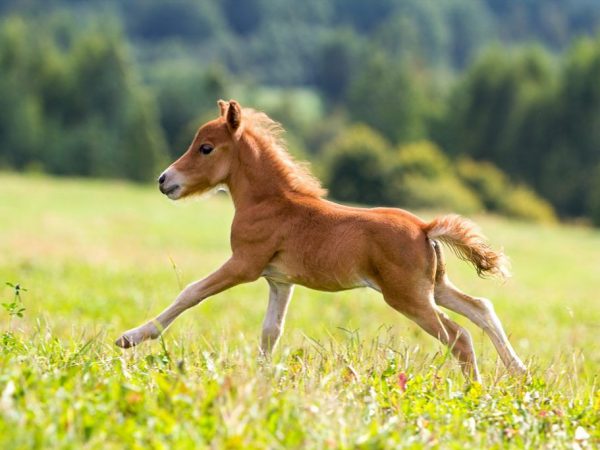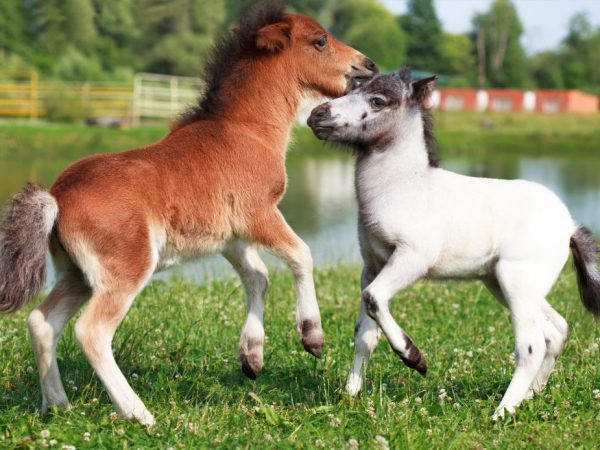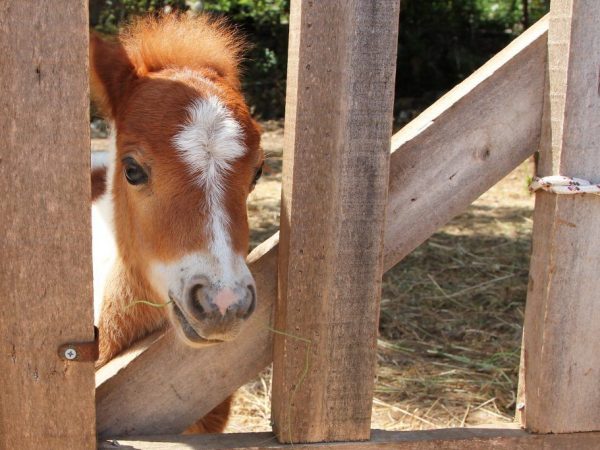Characteristics of the Falabella horse
The Falabella horse gets its famous name in honor of a kind and honest farmer. It was he who became the first to start breeding Falabella on his farm. The uniqueness of this breed lies in the fact that its representatives are very small in size. Often these babies are mistaken for Scottish ponies.

Description of the Falabella horse
general description
Horses of this breed cannot be called ponies in any way, since they have their own history of existence and are a unique and separate species, but very small, even miniature in size. At the withers, they reach only 87 cm, and their weight is 50 kg. An interesting fact is that all subsequent generations grow even smaller.
No one can clearly say where exactly this breed came from. Today, there are several theories of its appearance.
- The first says that horses are of Japanese origin. This opinion is based on a legend according to which Japanese magicians combined several wonderful herbs, boiled a magic barrel and created a miniature copy of a large horse. More often than not, no one takes this version seriously.
- According to the second version, once upon a time, representatives of wild horses fell into a strange, natural trap and, unfortunately, could not get out of there. Their neighing was heard by other representatives of the breed, because of which they also found themselves in a trap. They began to live and reproduce there. The cubs could not get enough calcium and vitamins, and therefore grew small in size. Then the farmer Falabell found them, took them out and began to breed them on his farm, gave this species its name.
No one can yet say exactly how this species appeared, it is because of this that it is difficult to trace their genetics, from where they got their qualities, beautiful and bright colors.
What is the difference from a pony?
Although very often Falabella is called a pony, they have many differences between themselves. Ponies are naturally small in stature and not as fast as a horse, he has a powerful physique that looks rough at its most. But with Falabella, everything is quite the opposite: they are very elegant, calm, all the lines of their body are soft and refined. There is no angularity or harshness in their body structure.
The largest horse of this breed has reached 86 cm. The mass of these bay ones will never be more than 66 kg, and the ponies are gaining up to 130 kg. The most striking and memorable representative of this breed was the stallion, its maximum height in adulthood was 35 cm, and its weight was 9.5 kg.

Falabella breed feature
Each new generation comes out less than the parents. Why this happens so far, no scientist in the world can explain, although a very large number of specialists have studied this feature of the breed. Even if they try to cross a horse with a mare of another breed, Falabella's genes will always triumph over others. As a result, a mini-horse will be born. This procedure is only possible in laboratories.
Falabella is not designed to transport goods or people. Horses can ride small children, but the main thing is not to overwork the animal.Such individuals are most often brought up for decorative and aesthetic purposes. The cost of such an animal is not small, therefore, not every person can afford such a creature. How much is a copy of a large horse now, it's hard to say, the price is constantly changing.
Features of such a horse
Outwardly, these animals are very attractive and cute, they are proportionally built. Many horse breeders say that when you look at these miniature creatures, it seems that they are small "fakes" of real and pure Arabian horses. As for character, there are no problems here. The animals are very kind, friendly, calm and curious (in moderation). Falabella very easily makes contact and, thanks to this, it is easy and simple to train the animal.
With children, Falabella immediately makes contact, treats them well. She is always glad to ride someone on herself, but only if the child behaves well, because no one will like it if they start pulling the hair out of the mane. The main advantage of this breed is that, due to its small size, in its speed it is in no way inferior to horses. Horses can cover long distances in a matter of minutes. In addition, they jump very high, play a lot and, in general, are very playful and active in nature. They are those representatives of the fauna who cannot sit in one place, they need space.
Care and maintenance rules
Oddly enough, but the Falabella is a very unpretentious breed, it does not require much attention to itself. But this does not mean that pets do not need to be looked after. Like other animals, these horses need care and a lot of love. Falabella loves nature very much, which is why it is best kept in an open pen so that she can frolic in the air. It is best to build a stable next to the paddock so that the pets can decide for themselves when they will be under a shed and warm, and when - in nature.

Falabella breed care
In the winter period, the bay ones must be transferred to a warm stable. Such a structure must be well "glued" so that there are no drafts anywhere and the heat remains only in the building. Also, in winter, it is necessary that the horses have constant access to hay, and it is best to cover the entire stable with them. The main rule for caring for bay is timely grooming of the coat. It is especially important to carefully monitor the animals during their molt: it usually takes place at the beginning or end of winter.
Falabella can get sick very easily, which is why the room where the breed representatives live in winter must be very warm and free of drafts. It is required to constantly give vitamins and calcium, to be vaccinated against tetanus and flu.
In the photo you can see how cute and tiny creatures they are, which must be protected.
Feeding the horses
It is important that horses have hay and fresh grass in their diet at all times. In addition, you need to constantly replenish the horses menu with different vegetables:
- carrot;
- cabbage;
- beet;
- potato.
Also, do not forget about apples and other fruits, which can be a source of nutrients. In this case, you should be very careful and give a little of everything: the animal may have an allergic reaction. Before pouring grains into the feeder, you should give the animal water so that it drinks as much as it can. Such a breed must be fed at least 3 times a day, water must be constantly available.
Breeding the breed
The mating period in horses is called the hunt. The female simply stands still, raises her tail and thus makes it clear to the males that the moment has come when it is time for them to act.
After conception, the female becomes calm, tries to run and jump as little as possible. When the moment of childbirth comes, she herself finds a secluded place and prepares for the process.
Babies often appear in early spring. Mom feeds them more than 50 times a day.The baby eats mother's milk for up to 9 months, then the female begins to drive him away and teaches how to eat properly in nature.
Falabella is a very interesting and unique breed that is more suitable for decorative purposes. An unpretentious and calm horse that loves space and freedom, it lends itself well to training.


